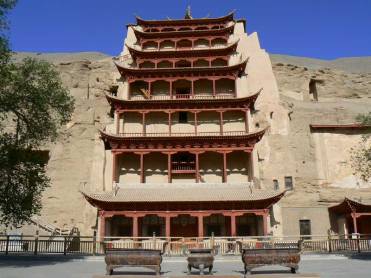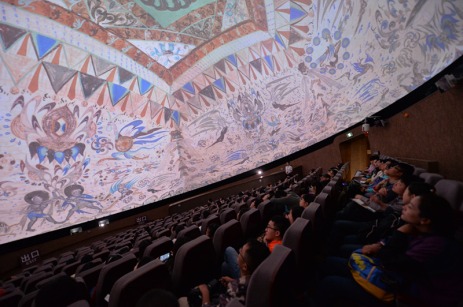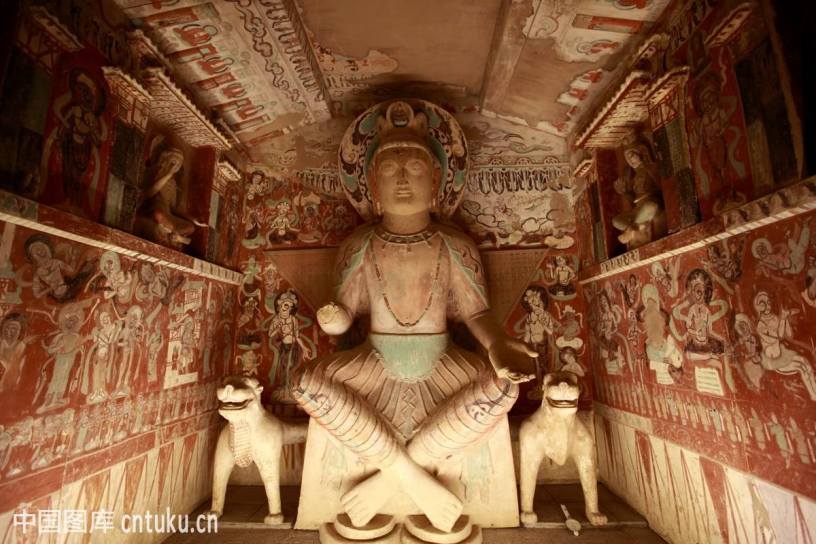 Introduction
Introduction
The Mogao Caves lie in Dunhuang, an important oasis and trading center of the Silk Road, in Gansu Province, China. With the prosperity of the Silk Road, Dunhuang attracted not only businessmen, but also Buddhist monks. They had built a complex of approximately 500 Buddhist cave temples and monasteries, which are later known as the Mogao Caves (WTO, 2004). Nowadays, the Mogao Caves have become a renowned tourist attraction that attracts thousands of visitors everyday. Undoubtedly, such an overload of tourists poses a serious threat to the protection (Demas, Agnew and Fan, 2015). In addition, the outside environment also facilitates its deterioration. Exposed to desert weather, the Mogao caves are negatively influenced by sandstorms, rainwater and other bad weather (Mikayama et al., 2018). In 1987, Mogao caves was granted World Heritage status, as part of the first group of sites listed in China.
 Fig 1.1 Dunhuang Mogao Ku
Fig 1.1 Dunhuang Mogao Ku
Discussion
Because the Mogao Caves are irreplaceable and nonrenewable, it is very important to preserve them. The Mogao Caves are not pure a tourist attraction, but a Buddhist pilgrimage as well, attracting a steady streams of pilgrims along with visitors every year. The issue of visit management cannot be negligible (Demas, Agnew and Fan, 2015).
 Fig 1.2 The Mogao caves witnessing overloads of visitors
Fig 1.2 The Mogao caves witnessing overloads of visitors
Located in a remote and underdeveloped area, the Mogao Caves have become a significant pillar of the local economy. About 80 percent of the caves are less than 85 square feet and cannot accommodate many visitors. However, the local government heavily depends on tourism, allowing too many people to enter the caves(Wong, 2015). The Mogao caves are very vulnerable because the paintings can be deteriorated by hygroscopic salts. Such density of visitors in the caves is likely to increase the humidity and CO2, which lead to the acceleration of deterioration (Maekawa, 1994) .
 Fig 1.3 Salt-related deterioration showing characteristic conditions of detachment
Fig 1.3 Salt-related deterioration showing characteristic conditions of detachment
and loss
To solve the problem, limiting the number of visitors is one of the important ways (Maekawa, 1994). It is suggested that management team should calculate the capacity of each caves. When the number of visitors reaches the maximum, the cave will be closed. It is also indicated that different routes can be But only this way is still far from the enough. It is suggested that the key point is to have people look at the art but without getting access to the caves.The introduce of 3D digital technology can make it happen (Hu, Ho and Qiao, 2017). It is possible to replicate the Mogao caves by making films of them. Then through 3D digital projections, visitors are able to view the paintings and sculptures just like they are personally in the caves (Ku, 2013). Moreover, there is no need to suffer from the bad environment and congestion inside the caves.
 Fig 1.4 The movie “Dream Buddhist Land” presenting views of some of most outstanding caves which are usually off limits to the public
Fig 1.4 The movie “Dream Buddhist Land” presenting views of some of most outstanding caves which are usually off limits to the public
Conclusion
Keeping the sustainable development of the Mogao caves requires that people cannot just develop tourism at the expense of protecting the World Heritage. Otherwise, the profit will run out sooner or later. In case the Mogao caves are overexploited for money, the local government should take the responsibility of overseeing the visit management. However, this does not mean developing tourism is not appropriate. The income from tourism can also contribute to preservation. Besides, cutting-edge technology make it possible to have people enjoy visiting without the hustle and bustle of travelling from one cave to another among huge crowds of people. Due to the vulnerability of the Mogao caves, limitation of access would make a huge difference.
Reference
Demas, M., Agnew, N. and Fan, J. (2015). Strategies for Sustainable Tourism at the Mogao Grottoes of Dunhuang, China. London: Springer, pp.1-5, 17-22.
Hu, X., Ho, E. and Qiao, C. (2017). Digitizing Dunhuang Cultural Heritage: A User Evaluation of Mogao Cave Panorama Digital Library. Journal of Data and Information Science, 2(3), pp.49-67
Ku, Ming-chun. 2013. Framing the Mogao Caves in the encounters between tourists and site interpreters. In Tourism and archaeology: sustainable meeting grounds, ed. Cameron Walker and Neil Carr, 195–210. Walnut Creek, CA: Left Coast Press
Maekawa, S. (1994). Preventive strategies for reducing the impact of visitors on the microenvironment of caves at the Mogao Grottoes. Studies in Conservation, 39(sup2), pp.76-79.
Mikayama, A., Hokoi, S., Ogura, D., Okada, K. and Su, B. (2018). The effects of windblown sand on the deterioration of mural paintings in cave 285, in Mogao caves, Dunhuang. Journal of Building Physics, p.174425911877338.
World Tourism Organization (WTO). 2004. Tourism congestion management at natural and cultural sites. A guidebook. Madrid: World Tourism Organization.
Wong, E. (2015). Plan for Theme Park at Centuries-Old Chinese Caves Rattles Preservationists. The new York Time, p.A8.
Fig1.1:https://en.wikipedia.org/wiki/Mogao_Caves#/media/File:Dunhuang_Mogao_Ku_2013.12.31_12-30-18.jpg
Fig1.2: https://www.google.com/search?biw=1366&bih=612&tbm=isch&sa=1&ei=feXGW9XUAqjsrgTd1pyYCQ&q=mogao+caves+crowds+&oq=mogao+caves+crowds+&gs_l=img.3…4293.6511.0.6678.8.8.0.0.0.0.128.894.1j7.8.0….0…1c.1.64.img..0.2.248…0i19k1j0i30i19k1.0.f9-NAPdiyIU#imgrc=3QVvpyfoNDagfM
Fig1.3 http://chinalawandpolicy.com/wp-content/uploads/2015/09/Mogao-5.png
Fig1.4 http://www.suitcaseandworld.com/2017/03/mogao-caves.html
